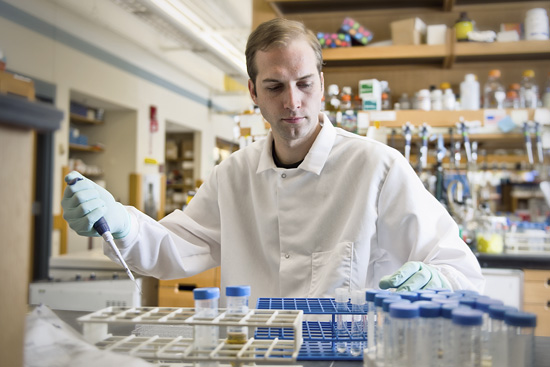ENG Student Named to Forbes “30 Under 30” List
Kyle Allison wins second major award

Kyle Allison (ENG’12) says he is thrilled to be named to the Forbes list of 30 of the nation’s most promising young scientists.
Most scientists spend years striving for the kind of recognition that 26-year-old Kyle Allison has achieved in the past few months. In November, the College of Engineering PhD candidate won first place and $15,000 in the annual Collegiate Inventors Competition for his discovery of a simple and inexpensive therapy for persistent infections. Now, Allison’s research has landed him a place on the Forbes “30 Under 30” science and innovation list. The special online edition was released last month.
Allison (ENG’12) says he is thrilled to be named to the Forbes list of 30 of the nation’s most promising young scientists.
“In the sciences people have definitely not done their most important work by the time they are 30, but they have made headway,” says Allison. “Given that I would like to continue this work, I’m thrilled I’ve been honored. I’m really glad with what I’ve accomplished, but there’s still a lot more that I am looking forward to doing.”
Allison’s research began more than four years ago when he joined the lab of James Collins, a William Fairfield Warren Distinguished Professor and an ENG professor of biomedical engineering. Collins, a MacArthur genius grant recipient, had suggested that Allison try to find a way to wake up the dormant bacteria that lead to persistent infections, such as staphylococcus and bacterial pneumonia. These dormant bacteria don’t absorb the antibiotics routinely used to treat infections. After working on the problem for two weeks, Allison told Collins he didn’t think there was a way to do it.
Collins encouraged him to keep going. Further research led Allison to hypothesize that if he could somehow stimulate the cells, they might start to absorb the antibiotics. More than a year later, he discovered that sugar worked as an energizing agent. The bacteria metabolized the sugar, and the cells began to absorb the antibiotics. Allison and Collins’ results were published in the journal Nature last May.
While their findings have yet to be tested in humans, Allison hopes the research will lead to an effective, low-cost treatment for chronic bacterial infections, such as staph and strep, which can adversely affect vital organs if not treated. The most significant impact of the research could be in the treatment of tuberculosis, a chronic bacterial infection of the lungs that according to the World Health Organization kills about 1.7 million people a year.
“I really started to appreciate the importance of the problem when I looked at the actual number of infections, the incidence, the dollar amounts, and the mortality rates these infections cause worldwide,” Allison says. “And I hope our work will inspire researchers to use this method on streptococcus pneumonia, which causes most cases of pneumonia in this country.”
Making the “30 Under 30” list came as a surprise to Allison. He was contacted by an editor at Forbes earlier this fall asking about his age and work . When weeks went by without hearing any more, he assumed he hadn’t made the cut. He didn’t know he had been selected from among hundreds of nominees until December, when a friend sent him a screenshot with his photo from the front page of Forbes.com.
The 30 scientists were chosen by a panel that included a cardiologist at the Scripps Research Institute, a Harvard physicist, a genomic technologist from Stanford, and Forbes writers Matthew Herper and Seline Jung. Among the other young scientists honored were the inventor of a mobile device that can detect preterm labor in high-risk pregnancies and alert doctors, the discoverer of a new noninvasive test for Down syndrome, and the creator of interactive theater, starring robots. In its special online edition, Forbes also published lists of people under 30 who have made significant contributions in other areas, including art and design, technology, and law and policy.
Allison says he is currently trying to determine whether his research could lead to a treatment for Pseudomonas aeruginosa, a pathogen that affects patients with cystic fibrosis and is extremely difficult to treat. He hopes to teach at the college level and inspire a new generation of scientists to find innovative ways to treat disease.
But for now he is basking in another milestone: earlier this month, Allison used some of the prize money from the Collegiate Inventors Competition to buy an engagement ring for his girlfriend. She said yes.

Comments & Discussion
Boston University moderates comments to facilitate an informed, substantive, civil conversation. Abusive, profane, self-promotional, misleading, incoherent or off-topic comments will be rejected. Moderators are staffed during regular business hours (EST) and can only accept comments written in English. Statistics or facts must include a citation or a link to the citation.